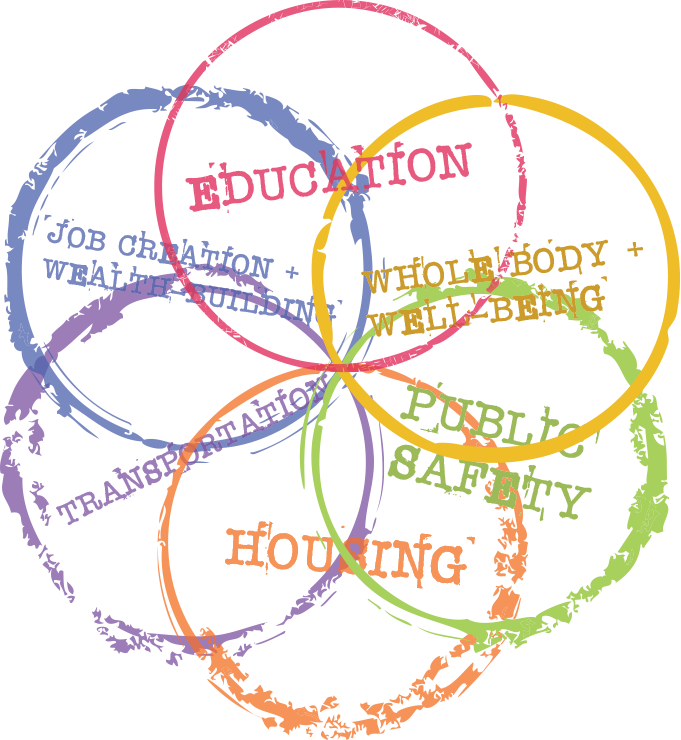Public Safety in Richmond Isn't Possible Without Community Justice
By Adrienne Cole Johnson, Lillie A. Estes, Howard Manly, and Kristin Reed
Published in the Richmond-Times Dispatch on May 13, 2017
Public safety and community justice are not mutually exclusive, societal objectives. In theory the goals of both are broadly rooted in the U.S. Constitution and daily demonstrated — for better and for worse — on American streets.
In reality, it is necessary that we deepen our perspective on public safety as a community justice concern, in order to ensure just and equitable communities throughout our beloved city. There cannot be public safety without community justice, because without community justice, only some are safe.
We suggest that at the root of public safety is the basic human desire to live in consciously caring neighborhoods, where children are able to play outside without worry, where elders are comfortable with moving about, and where there is a sense of community, respect, and neighborliness. When we understand how these ideals are necessary to one another, we are better able to assert our needs — to one another as citizens as well as through policy and law.
***
As we ground these conversations in the core principles of community justice, it is necessary for us to design and create spaces that offer safe habitation for all of our community members, regardless of income, ability, or identity.
Too often we are not completely committed to safety for all. We neglect our brothers and sisters across the water and across the bridge because it is not our backyard. Quite honestly, while our city is still growing in togetherness, the silo approach of public safety is still quite prevalent. Understanding how each area affects the other allows us to feel more connected to the great things that are happening in the city as well as to the major areas for improvement and concern.
In the unfortunate case where public safety is threatened, we must respond with the intent to repair what we can and to reduce the likelihood that harm will occur again. In efforts to advance the principles of justice, it is necessary that we not only hold individuals accountable for their actions, but we must also question the systems and policies that have failed us.
We should favor policies that are rehabilitative and restorative in practice. Research and experience shows that taking this approach has positive budgetary effects as well as a deeper and collective impact on communities. Investment in systems that anticipate and prevent harm — versus some of our more reactive models — reinforces a holistic approach to safety, and public safety as a community justice issue must be viewed in a holistic lens.
Policies that treat underlying concerns are not just important, they are necessary for growth. If we value public safety, we must shift our focus from the reformation of our current system to the re-thinking of a system built on more just foundations and capable of doing more good than harm.
Whether due to budget constraints or policies, we can no longer talk about public safety without demanding a safe public for all of our citizens.
We must pay close attention to what lawmakers are willing to spend to maintain safety and establish a criminal justice system that is perceived to be fair and equitable.
***
In Richmond, the budget for the Richmond Police Department’s “community outreach” line item dropped a little less than $10,000 from fiscal year 2016 to $2.4 million in fiscal year 2017. But the line item for “Public Safety and Well-Being” dropped substantially from $1.2 million in fiscal year 2016 to a paltry $259,000 in fiscal year 2017.
Without parsing the meaning of phrases like “community outreach” and “well-being,” it appears that there is a difference in priority with regards to a budget that leaves insignificant public money for community justice efforts, while showing there is a “tough-on-crime” approach at the expense of being a smart-on-safety-conscious city.
Parole abolition, mandatory sentencing guidelines, disproportionality in our school-to-confinement pipeline, and the 21-day rule on evidence remain persistent obstacles to meaningful reform.
Yet in some instances, the tide is moving slowly toward a community justice model. Closing juvenile prisons throughout the commonwealth and using the savings to establish community-based programs for non-violent defendants is a good first step.
So what can we do, individually and collectively, to make community justice part of the public safety conversation? One of the most powerful things we can do is to simply show up. We must be present at budget hearings, consistently involved in public safety commissions and initiatives, and, above all, we must ensure that all persons — despite socio-economic status or ZIP code — are protected. Their well-being and feeling safe in their neighborhoods and communities are important factors.
As stated by Dr. Martin Luther King Jr., “True peace is not merely the absence of tension: it is the presence of justice.”
Public safety must address the massive generational neglect from community disinvestment, and may we remind ourselves that safety is inseparable from justice as we continue to define and create a just community of citizens in Richmond — even and especially including those disproportionately subject to criminalization.
***
Our community justice film premier screening on public safety is this week! Please get engaged and involved and join us Wednesday, May 17 at the Calhoun Family Investment Center (436 Calhoun Street, Richmond, Va. 23220) beginning at 6 p.m. and ending at 8:30 p.m. We will move beyond the big screen into open, lively, and real conversation — all with the aim of building effective community justice practices in our city.
